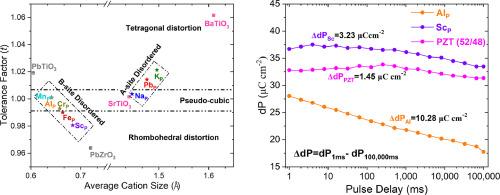当前位置:
X-MOL 学术
›
Acta Mater.
›
论文详情
Our official English website, www.x-mol.net, welcomes your
feedback! (Note: you will need to create a separate account there.)
Polarization Stability and Its Influence on Electrocaloric Effects of High Entropy Perovskite Oxide Films
Acta Materialia ( IF 8.3 ) Pub Date : 2024-11-17 , DOI: 10.1016/j.actamat.2024.120576 Yeongwoo Son, Stanislav Udovenko, Sai Venkatra Gayathri Ayyagari, John Barber, Kae Nakamura, Christina M. Rost, Nasim Alem, Susan Trolier-McKinstry
Acta Materialia ( IF 8.3 ) Pub Date : 2024-11-17 , DOI: 10.1016/j.actamat.2024.120576 Yeongwoo Son, Stanislav Udovenko, Sai Venkatra Gayathri Ayyagari, John Barber, Kae Nakamura, Christina M. Rost, Nasim Alem, Susan Trolier-McKinstry

|
In principle, the configurational entropy inherent in High Entropy Oxides (HEOs) could facilitate large electrocaloric effects (ECE) by promoting polar entropy. In this study, it is demonstrated that the time stability of the remanent polarization can be tuned via B-site disorder in High Entropy Perovskite Oxides (HEPO) films. Eight HEPO powders were synthesized; the propensity for perovskite phase formation was consistent with the Goldschmidt tolerance factor. While entropic contributions stabilize HEPO, they do not fully predict the stabilization. Relative dielectric permittivities between 2000 to 600 can be achieved for the B-site disordered HEPO films with loss tangents below 6% at room temperature. All films showed similar polarization-electric field loops with maximum polarization up to 48 cm−2 and a remanent polarization 20 cm−2 measured at room temperature with applied electric field of 1100 kV cm−1 at a frequency of 10 kHz. The temperature of the dielectric maximum (Tmax) increased from 105°C to 225°C with increasing average ion size on the B-site. Polarization stability of the HEPO films was investigated using Positive-Up-Negative-Down (PUND) measurements. It was found that in some HEPO films, 24% of the remanent polarization decayed within 2 s. By employing the time stability of the remanent polarization, enhanced electrocaloric effects of HEPO film was predicted to be 14.9 K and 11.5 J Kg−1 K−1 at an applied field of 1120 kV cm−1, for electrocaloric temperature change and entropy change, respectively.
中文翻译:

极化稳定性及其对高熵钙钛矿氧化物薄膜电热效应的影响
原则上,高熵氧化物 (HEO) 中固有的构型熵可以通过促进极性熵来促进大电热效应 (ECE)。在这项研究中,证明剩余极化的时间稳定性可以通过高熵钙钛矿氧化物 (HEPO) 薄膜中的 B 位点无序来调节。合成了 8 种 HEPO 粉末;钙钛矿相形成的倾向与 Goldschmidt 容差因子一致。虽然熵贡献稳定了 HEPO,但它们并不能完全预测稳定。对于在室温下损耗角正切低于 6% 的 B 位点无序 HEPO 薄膜,可以实现 2000 到 600 之间的相对介电常数。所有薄膜都显示出相似的极化-电场环,最大极化高达 48 cm−2 和残余极化 20 cm-2 在室温下以 1100 kV cm-1 的频率和 10 kHz 的频率测量。随着 B 位点平均离子尺寸的增加,最大介电温度 (Tmax) 从 105°C 增加到 225°C。使用 Positive-Up-Negative-Down (PUND) 测量研究了 HEPO 薄膜的极化稳定性。 研究发现,在一些 HEPO 薄膜中,24% 的剩余极化在 2 秒内衰减。通过采用剩余极化的时间稳定性,在 1120 kV cm-1 的外加磁场下,HEPO 薄膜的增强电热效应分别为 14.9 K 和 11.5 J Kg-1 K-1,对于电热温度变化和熵变。
更新日期:2024-11-18
中文翻译:

极化稳定性及其对高熵钙钛矿氧化物薄膜电热效应的影响
原则上,高熵氧化物 (HEO) 中固有的构型熵可以通过促进极性熵来促进大电热效应 (ECE)。在这项研究中,证明剩余极化的时间稳定性可以通过高熵钙钛矿氧化物 (HEPO) 薄膜中的 B 位点无序来调节。合成了 8 种 HEPO 粉末;钙钛矿相形成的倾向与 Goldschmidt 容差因子一致。虽然熵贡献稳定了 HEPO,但它们并不能完全预测稳定。对于在室温下损耗角正切低于 6% 的 B 位点无序 HEPO 薄膜,可以实现 2000 到 600 之间的相对介电常数。所有薄膜都显示出相似的极化-电场环,最大极化高达 48 cm−2 和残余极化 20 cm-2 在室温下以 1100 kV cm-1 的频率和 10 kHz 的频率测量。随着 B 位点平均离子尺寸的增加,最大介电温度 (Tmax) 从 105°C 增加到 225°C。使用 Positive-Up-Negative-Down (PUND) 测量研究了 HEPO 薄膜的极化稳定性。 研究发现,在一些 HEPO 薄膜中,24% 的剩余极化在 2 秒内衰减。通过采用剩余极化的时间稳定性,在 1120 kV cm-1 的外加磁场下,HEPO 薄膜的增强电热效应分别为 14.9 K 和 11.5 J Kg-1 K-1,对于电热温度变化和熵变。


















































 京公网安备 11010802027423号
京公网安备 11010802027423号